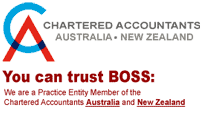IT
An outsourcing provider typically presents three distinct approaches for collaboration with your organisation in the realm of IT services.
The Cloud
Among the three options, this one is the most straightforward. You may only need to provide your overseas team members with login credentials, granting them access to your clients’ files. For any supporting documents stored outside of the cloud system, you can utilise Dropbox or similar services.
BOSS offers a web portal as an alternative however services like Dropbox are sometimes preferred by clients.
Work online
The initial online work configuration involves utilising a Terminal Server or Citrix Server to grant outsourced accountants access in the same manner as in-house personnel.
The second configuration requires the use of a Small Business Server (SBS). In this scenario, an additional computer must be connected to the SBS for each outsourced accountant. Offshore team members will connect to this designated computer via Windows Remote Desktop.
There are several additional configurations available; however, we do not recommend implementing them due to concerns regarding security and performance.
In any scenario, it is essential to verify the speed of your connections with your outsourcing provider. The critical metric in this evaluation is your upload speed rather than the download speed. Should you find that your upload speeds are insufficient, you may need to consider upgrading one or more components such as your server, workstation, or router. Alternatively, it may be necessary to revise your Internet Service Provider plan or switch providers altogether.
Your physical proximity to the Telstra Exchange may influence the speed and quality of your connection. In instances where distance impacts performance, we recommend collocating servers in a central data centre that employs fibre-optic communication to enhance speed.
To facilitate this process, you would need to upload all relevant documents—including client ledgers, tax files, last year’s working papers, tax returns, and supporting documentation—to a secure service such as Dropbox or directly onto the outsourcing provider’s web server.
Additionally, it is imperative that your accounting outsourcing provider possess the necessary software you utilise (including all pertinent versions).
This additional step typically requires an extra 5-10 minutes for each job.
Staff
It is essential to prepare your staff for the upcoming changes. The term “outsourcing” can often lead individuals to mistakenly perceive it as a signal of impending downsizing, rather than recognizing the potential opportunities for growth that it may offer.
To prevent any potential concerns within the office, it is essential to ensure that your staff is informed of the following:
- that you’re doing this in order to grow, not downsize
- how outsourcing is going to help you meet the milestones you’ve set for your firm
- how their job descriptions are going to change and improve
- how outsourcing is going to benefit them
- how the new workflow will work
- that there will be a period where that outsourcing-related workflow will need to be tweaked and that you’re going to want their help in making it all run as smoothly as possible
Internal processes
Two essential elements of successful outsourcing integration are organisation and communication. It is important to note that the transition to working with an outsourced accountant will not significantly alter your existing workflow.
In preparing for a job, it remains essential to gather all relevant information as you currently do. However, it is imperative to maintain discipline and refrain from sending any materials to the outsourced accountant until you have compiled all necessary data. This approach prevents delays that can occur when documentation is submitted in fragments.
Outsourced service providers are equipped to acclimate to your internal procedures and working papers. For instance, BOSS will provide you with a questionnaire prior to the transfer of your initial file. This document may include inquiries such as, “What constitutes a material difference when reconciling GST?” ensuring that your offshore team has a comprehensive understanding of your standards and methodologies.
It is also advisable to obtain answers to all queries from your client at once (or at most, in two sets) so that consolidated information can be efficiently relayed back and forth between you and your offshore accountant within an appropriate time frame.
Informing Clients
Under current Australian and New Zealand legislation, it is now mandatory to inform clients when outsourced workers will be utilised, irrespective of whether these individuals are contractors based in Australia. A subtle communication strategy tends to be most effective in assuring clients that their personal information remains secure.
To comply with this requirement, we recommend integrating a brief statement into your engagement letter. This approach ensures that clients are adequately informed while maintaining a discreet tone.
Dear [Client],
Just like you, we here at [your firm] are operating a business, which means that we experience the same pressures and frustrations as many of you. We have difficulty finding professional staff and trying to keep costs down is a constant battle.
We are now employing a number of strategies which we hope will keep our costs down, thereby allowing us to remain competitive with the fees we charge.
One of these strategies is to outsource [compliance, bookkeeping, payroll, etc.] work. We currently have a relationship with a company operating out of Sydney which provides qualified accounting professionals working from offices in India.
The firm holds a Practising Certificate from the CAANZ and operates to extremely high ethical, privacy, and security standards. These accountants have limited access to our database, and are able to cost-effectively undertake accounting and tax functions.
This frees up the time of our highly qualified team and allows us to add value to you and your business, rather than attending to compliance obligations.




